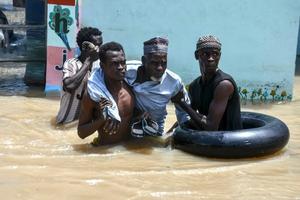Lake Chad Basin: Drying, Floods, Heat—And What Lies Between
Once spanning 25,000 km² in the 1960s, Lake Chad—shared by Nigeria, Chad, Niger, and Cameroon—has shrunk by nearly 90%, threatening the livelihoods of over 30 million people who depend on it for farming, fishing, and herding (Lake Chad Basin Commission [LCBC], 2023). Today, the crisis extends beyond drying: floods, dam failures, and climate change are straining fragile socio-ecological systems.
The Paradox of Water Extremes
In recent years, the region has witnessed a troubling duality. Prolonged droughts have been combined with devastating floods. The Alau Dam near Maiduguri, Nigeria, overflowed in September 2024 after intense rainfall, submerging neighbourhoods, displacing over 150,000 people, and claiming more than 200 lives (Aluko, 2024).
Across Chad and Cameroon, the Chari and Logone Rivers have repeatedly flooded low-lying communities, while those same areas face water scarcity just months later. These alternating extremes show how climate change is reshaping hydrological patterns, rain events are more erratic and intense, while dry seasons last longer and bite harder (LCBC, 2023).
However, these extremes are not unique to Lake Chad. From Pakistan’s record monsoon floods to droughts in Europe, the Middle East, and South America, communities worldwide face similar patterns of having too much water or too little. The difference lies in the capacity to respond. In the Lake Chad Basin, high poverty, limited infrastructure, and weak institutions make unassisted planning and disaster response nearly impossible. As the UN Office for Disaster Risk Reduction (UNDRR) notes, “A hazard becomes a disaster when it exceeds the capacity of a community to cope” (UNDRR, 2015, p. 9).
Each flood or drought therefore hits harder, lasts longer, and leaves deeper scars—because local and national coping systems are already overstretched.
Why It Happens
Most scholars attribute these extremes largely to climate change, with average temperatures rising 1.5 °C in 50 years and erratic rainfall increasing evaporation and reducing lake recharge (LCBC, 2023). Rainy days are fewer, but downpours are heavier, causing floods followed by prolonged droughts.
Aging Infrastructure: Dams, dykes, and canals—many built decades ago for past climate conditions—are deteriorating. Siltation, weakened spillways, and poor monitoring mean that they overflow during heavy rains and fail to store water during dry periods (World Bank, 2024).
Governance and Funding Gaps: Weak coordination, outdated data, and underfunded disaster-preparedness programs leave systems fragile. Early-warning networks are patchy or non-existent across much of the basin (UNDRR, 2015).
Sustainable Solutions
Addressing these challenges requires practical actions aligned with the Sustainable Development Goals (SDGs).
SDG 9 – Industry, Innovation and Infrastructure.
The new Integrated Water Resources Management and Early Warning System for Climate Resilience in the Lake Chad Basin—funded at US$11.6 million will improve real-time monitoring across countries (LCBC, 2023).
Nigeria has also proposed a US$15 billion inter-basin water transfer from the Congo Basin (THISDAYLIVE, 2016), while a smaller conceptual solar-powered pipeline project (estimated at about US$267 million) aims to pump water from the Ubangi River to replenish about 3,000 km² in its first year (Save Lake Chad Initiative, 2022).
Meanwhile, a US$170 million World Bank project is upgrading roads and logistics in Chad’s Lake region to improve access and resilience (World Bank, 2024).
SDG 11 – Sustainable Cities and Communities
Urban flooding can be reduced through improved drainage, strict zoning to prevent development in flood-prone areas, and enhanced housing resilience. Building codes and community training can save lives and assets during extreme weather events (NRC, 2024).
SDG 13 – Climate Action
Stronger climate-adaptation frameworks combining early-warning systems, catchment restoration, and nature-based solutions—are essential. Restoration of wetlands and reforestation can buffer floods and recharge groundwater (UNDRR, 2015).
A Call for Regional Solidarity
Given the huge associated costs and the dire economic situations of the countries surrounding Lake Chad, regional cooperation has never been more urgent. In several basin countries, a sizeable portion of the national budget is funded through borrowing, as revenues fall short. On average, the basin nations face budget deficits and debt levels equivalent to roughly one-quarter of their annual revenues or GDP, reflecting a shared fiscal vulnerability and the need for coordinated, cost-effective solutions (World Bank, 2024).
The Lake Chad Basin stands at a crossroads. Its story embodies both the fragility of human engineering under climate stress and the resilience of its people. Sustainable recovery will require not only dams and dykes, but also data, governance, and solidarity.
The basin countries need not depend entirely on external assistance. Regional agencies and institutions can be mobilized to develop home-grown solutions—building technical expertise for community-based action, mobilizing domestic and private resources, and strengthening shared communication and coordination. By acting together, the Lake Chad Basin can transform what seems a near-hopeless situation into a living symbol of resilience, cooperation, and sustainable adaptation.
References
Aluko, O. (2024, September 11). Maiduguri flood: Over 150,000 displaced after Alau Dam overflow. Premium Times Nigeria.
Lake Chad Basin Commission (LCBC). (2023). Regional strategy for the stabilization, recovery, and resilience of the Lake Chad Basin.
Norwegian Refugee Council (NRC). (2024, October). Severe floods hitting most vulnerable in Sahel and Lake Chad region.
Save Lake Chad Initiative. (2022). Inter-Basin Water Transfer Concept and Pilot Project Summary. https://www.savelakechad.org
THISDAYLIVE. (2016, May 16). FG plans to recharge Lake Chad at estimated cost of $15 bn. https://www.thisdaylive.com
United Nations Office for Disaster Risk Reduction (UNDRR). (2015). Sendai Framework for Disaster Risk Reduction 2015–2030.
World Bank. (2024). Lake Chad Region Recovery and Development Project (P161706). https://projects.worldbank.org
Text: Emmanuel Chinonyerem Okpala
